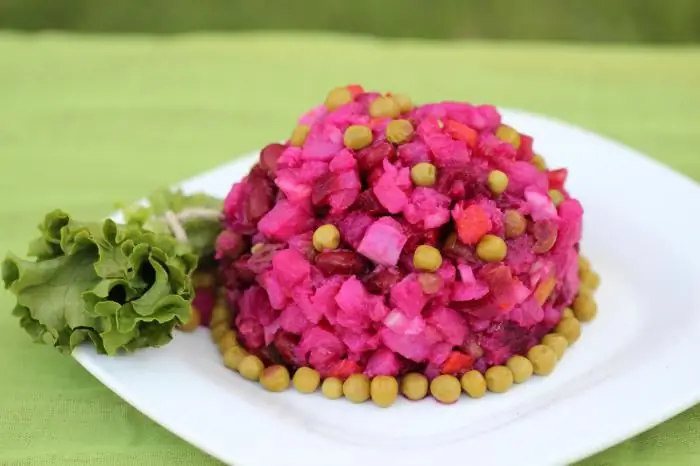2025 Author: Isabella Gilson | [email protected]. Last modified: 2025-01-23 12:50:38
Mentions of Ivan-tea take place in the chronicles of the 12th century. Already at that time it began to be called "Koporsky tea" in connection with the area where it grew in large quantities. Tea was highly valued for the unique properties it possessed. They successfully treated headaches and inflammations of various origins. Dried leaves were added to flour, from which bread was baked. Young leaves were used to make a salad.

How to collect Koporye tea
The raw material for tea is fireweed angustifolia. Usually the tops of the plant are used. The leaves break off easily if you hold your hand down, and the flowers, on the contrary, up. When collecting, you should carefully consider the quality of the leaves. If they began to dry out or are affected by something, then it is better not to tear them. The first grade is obtained only from young plants. There are especially many of them in May. Koporye tea is harvested during the growing moon, when there is no dew. During this period, it contains the largest amount of useful substances.

Processing of raw materials
In this case, this process is called fermentation. First harvested leavesdried. To do this, they are laid out in an even layer, about five centimeters thick. It is very important to avoid exposure to sunlight. After a few hours, the leaves are ground and rolled into sausages, while the leaves and flowers should give juice. This is a very important point, since it is the juice that creates the unique taste and aroma.
The resulting mass is folded into an enameled or plastic bowl and put under pressure. In this state, the future tea spends about 12 hours. In this case, you get a rich green tea. If you want to get black, then you need to keep it longer.
The end of fermentation can be judged by the smell. At first, Koporye tea smells like freshly cut grass. Then the fragrance changes to a floral one. Feeling it, you can start drying.
How to dry Kopor tea
At the final stage, the raw materials must be dried. In the hot season, this can be done under a canopy, but not in the sun. The rest of the time, the tea is perfectly dried in the oven at a temperature of 100 degrees. To prevent it from burning, it is necessary to turn regularly, as well as provide ventilation.

Readiness is easy to check. In this case, the leaves and flowers will break, but not crumble. The smell should be pleasant. Time is hard to calculate. It depends on humidity, layer thickness, temperature and so on. If the layer is about four centimeters, and the temperature is 100 degrees, then two hours are enough for drying. Please note that there must be a divider at the bottom of the oven, otherwise the bottom layer willoverheat.
How to store
After drying, the tea is transferred to a non-metallic bowl. Sunlight must be avoided. If you store in glass jars, then they should be placed in dark places or opaque bags. The best properties and taste qualities appear in tea after about a month. In this regard, do not rush to taste it.
Tea from the shop
Koporsky tea is quite easy to buy, for example, in specialized stores. However, you should be careful when buying: fakes or low-quality fees are very often offered.
Recommended:
Traditional Russian dishes

Since ancient times, such heat treatment as frying, which appeared relatively recently, has not been used in cooking. Products were cooked not on an open fire, but in an oven. For the most part, traditional Russian dishes were languishing, stewed or boiled
A dish that is called Russian all over the world. Dishes of Russian cuisine

Once upon a time, the inhabitants of Europe were practically not interested in the traditions of Russian cuisine, due to the low sophistication of its dishes. However, this pretentious attitude did not play a significant role and, on the contrary, served as a motivating mechanism for the emergence of new recipes
Stuffed herring - a traditional Russian dish

Stuffed herring - an extravagant serving of a fish dish to the table. It is prepared in an elementary way, but it turns out appetizing, it looks exceptionally on the festive table. They prepare a similar dish in advance, before the feast, the workpiece is only cut and laid out on plates
Traditional Russian cold appetizer jelly. Calorie content of the dish and recipes for its preparation

One of the traditional Russian snacks for most winter holidays is jelly. The calorie content of this dish can vary depending on the ingredients used, and the taste (when properly prepared) is always excellent. How can you cook high-calorie aspic and how this dish can be made dietary, more on that later
Traditional Russian breakfast. Delicious and he althy breakfasts: recipes for every day

Russia is a multinational country with long established culinary traditions. From time immemorial, local residents have been engaged in farming and farming, which means that vegetables, fruits, berries, cereals, meat and dairy products were constantly on the tables. Because their diet has always been varied. In the morning, they usually used all kinds of cereals, pancakes, pancakes, dumplings and cottage cheese casseroles. Today's article contains the most popular recipes for delicious breakfasts for every day

